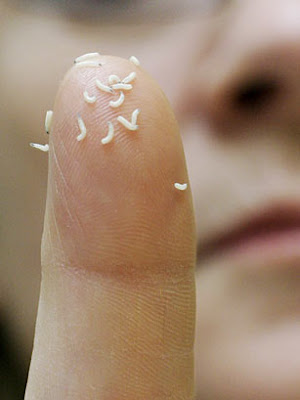Taking a deep drag on his cigarette while resting on the steering wheel of his truck, he looks like a parody of a middle-aged lorry driver.
But the image covers up a much more disturbing truth: At just the tender age of two, Ardi Rizal's health has been so ruined by his 40-a-day habit that he now struggles to move by himself.
The four-stone Indonesia toddler is certainly far too unfit to run around with other children - and his condition is set to rapidly deteriorate.
 But, despite local officials' offer to buy the Rizal family a new car if the boy quits, his parents feel unable to stop him because he throws massive tantrums if they don't indulge him.
But, despite local officials' offer to buy the Rizal family a new car if the boy quits, his parents feel unable to stop him because he throws massive tantrums if they don't indulge him.
His mother, Diana, 26, wept: 'He's totally addicted. If he doesn't get cigarettes, he gets angry and screams and batters his head against the wall. He tells me he feels dizzy and sick.'
Ardi will smoke only one brand and his habit costs his parents £3.78 a day in Musi Banyuasin, in Indonesia's South Sumatra province.
But in spite of this, his fishmonger father Mohammed, 30, said: 'He looks pretty healthy to me. I don't see the problem.'
Ardi's youth is the extreme of a disturbing trend. Data from the Central Statistics Agency showed 25 per cent of Indonesian children aged three to 15 have tried cigarettes, with 3.2 per cent of those active smokers.
The percentage of five to nine year olds lighting up increased from 0.4 per cent in 2001 to 2.8 per cent in 2004, the agency reported.
 A video of a four-year-old Indonesian boy blowing smoke rings appeared briefly on YouTube in March, prompting outrage before it was removed from the site.
A video of a four-year-old Indonesian boy blowing smoke rings appeared briefly on YouTube in March, prompting outrage before it was removed from the site.
Child advocates are speaking out about the health damage to children from second-hand smoke, and the growing pressure on them to smoke in a country where one-third of the population uses tobacco and single cigarettes can be bought for a few cents.
Seto Mulyadi, chairman of Indonesia's child protection commission, blames the increase on aggressive advertising and parents who are smokers.
'A law to protect children and passive smokers should be introduced immediately in this country,' he said.
A health law passed in 2009 formally recognizes that smoking is addictive, and an anti-smoking coalition is pushing for tighter restrictions on smoking in public places, advertising bans and bigger health warnings on cigarette packages.
 But a bill on tobacco control has been stalled because of opposition from the tobacco industry.
But a bill on tobacco control has been stalled because of opposition from the tobacco industry.
The bill would ban cigarette advertising and sponsorship, prohibit smoking in public, and add graphic images to packaging.
Benny Wahyudi, a senior official at the Industry Ministry, said the government had initiated a plan to try to limit the number of smokers, including dropping production to 240 billion cigarettes this year, from 245 billion in 2009.
'The government is aware of the impact of smoking on health and has taken efforts, including lowering cigarette production, increasing its tax and limiting smoking areas,' he said.
Mr Mulyadi said a ban on advertising is key to putting the brakes on child and teen smoking.
'If cigarette advertising is not banned, there will be more kids whose lives are threatened because of smoking,' he said.
Ubiquitous advertising hit a bump last month when a cigarette company was forced to withdraw its sponsorship of pop star Kelly Clarkson's concert following protests from fans and anti-tobacco groups.
 However, imposing a non-smoking message will be difficult in Indonesia, the world's third-largest tobacco consumer.
However, imposing a non-smoking message will be difficult in Indonesia, the world's third-largest tobacco consumer.
Tubagus Haryo Karbyanto, a member of the National Commission of Tobacco Control, said Indonesia must also address the social conditions that lead to smoking, such as family influence and peer pressure.
'The promotion of health has to be integrated down to the smallest units in our society, from public health centres and local health care centres to the family,' he was quoted as saying by the Jakarta Globe on Friday.
Health Minister Endang Sedyaningsih conceded turning young people off smoking will be difficult in a country where it is perceived as positive because cigarette companies sponsor everything from scholarships to sporting events.
'This is the challenge we face in protecting youth from the dangers of smoking,' she said in a statement on the ministry's website.
But the image covers up a much more disturbing truth: At just the tender age of two, Ardi Rizal's health has been so ruined by his 40-a-day habit that he now struggles to move by himself.
The four-stone Indonesia toddler is certainly far too unfit to run around with other children - and his condition is set to rapidly deteriorate.
 But, despite local officials' offer to buy the Rizal family a new car if the boy quits, his parents feel unable to stop him because he throws massive tantrums if they don't indulge him.
But, despite local officials' offer to buy the Rizal family a new car if the boy quits, his parents feel unable to stop him because he throws massive tantrums if they don't indulge him. His mother, Diana, 26, wept: 'He's totally addicted. If he doesn't get cigarettes, he gets angry and screams and batters his head against the wall. He tells me he feels dizzy and sick.'
Ardi will smoke only one brand and his habit costs his parents £3.78 a day in Musi Banyuasin, in Indonesia's South Sumatra province.
But in spite of this, his fishmonger father Mohammed, 30, said: 'He looks pretty healthy to me. I don't see the problem.'
Ardi's youth is the extreme of a disturbing trend. Data from the Central Statistics Agency showed 25 per cent of Indonesian children aged three to 15 have tried cigarettes, with 3.2 per cent of those active smokers.
The percentage of five to nine year olds lighting up increased from 0.4 per cent in 2001 to 2.8 per cent in 2004, the agency reported.
 A video of a four-year-old Indonesian boy blowing smoke rings appeared briefly on YouTube in March, prompting outrage before it was removed from the site.
A video of a four-year-old Indonesian boy blowing smoke rings appeared briefly on YouTube in March, prompting outrage before it was removed from the site.Child advocates are speaking out about the health damage to children from second-hand smoke, and the growing pressure on them to smoke in a country where one-third of the population uses tobacco and single cigarettes can be bought for a few cents.
Seto Mulyadi, chairman of Indonesia's child protection commission, blames the increase on aggressive advertising and parents who are smokers.
'A law to protect children and passive smokers should be introduced immediately in this country,' he said.
A health law passed in 2009 formally recognizes that smoking is addictive, and an anti-smoking coalition is pushing for tighter restrictions on smoking in public places, advertising bans and bigger health warnings on cigarette packages.
 But a bill on tobacco control has been stalled because of opposition from the tobacco industry.
But a bill on tobacco control has been stalled because of opposition from the tobacco industry.The bill would ban cigarette advertising and sponsorship, prohibit smoking in public, and add graphic images to packaging.
Benny Wahyudi, a senior official at the Industry Ministry, said the government had initiated a plan to try to limit the number of smokers, including dropping production to 240 billion cigarettes this year, from 245 billion in 2009.
'The government is aware of the impact of smoking on health and has taken efforts, including lowering cigarette production, increasing its tax and limiting smoking areas,' he said.
Mr Mulyadi said a ban on advertising is key to putting the brakes on child and teen smoking.
'If cigarette advertising is not banned, there will be more kids whose lives are threatened because of smoking,' he said.
Ubiquitous advertising hit a bump last month when a cigarette company was forced to withdraw its sponsorship of pop star Kelly Clarkson's concert following protests from fans and anti-tobacco groups.
 However, imposing a non-smoking message will be difficult in Indonesia, the world's third-largest tobacco consumer.
However, imposing a non-smoking message will be difficult in Indonesia, the world's third-largest tobacco consumer.Tubagus Haryo Karbyanto, a member of the National Commission of Tobacco Control, said Indonesia must also address the social conditions that lead to smoking, such as family influence and peer pressure.
'The promotion of health has to be integrated down to the smallest units in our society, from public health centres and local health care centres to the family,' he was quoted as saying by the Jakarta Globe on Friday.
Health Minister Endang Sedyaningsih conceded turning young people off smoking will be difficult in a country where it is perceived as positive because cigarette companies sponsor everything from scholarships to sporting events.
'This is the challenge we face in protecting youth from the dangers of smoking,' she said in a statement on the ministry's website.



















































